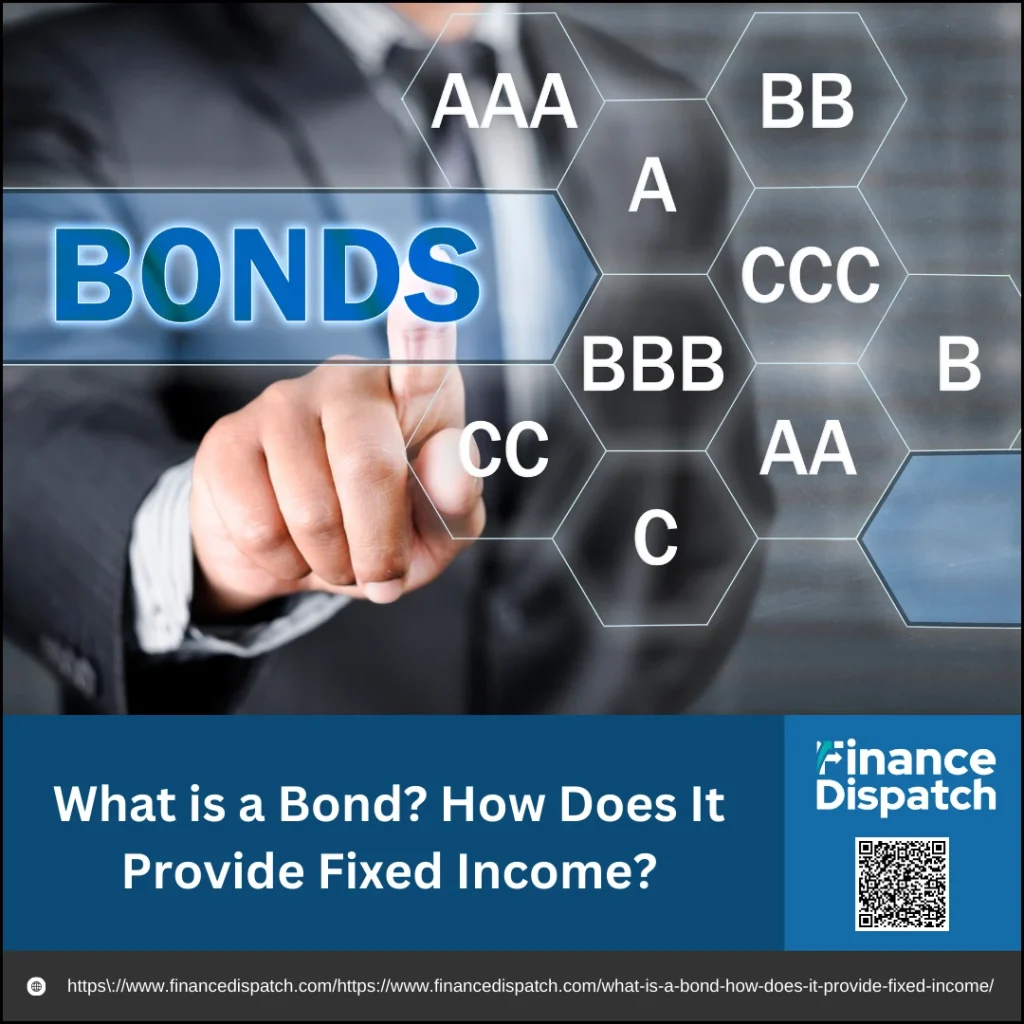When you’re looking for a steady and reliable way to grow your money, bonds can be an appealing option. A bond is a type of fixed income investment that allows you to earn regular interest while helping governments or companies fund their projects. Unlike stocks, which can swing wildly in value, bonds typically offer more stability and predictable returns. In this article, we’ll break down what a bond is, how it works, and why it’s a valuable tool for generating fixed income in your investment portfolio.
What is a Bond?
A bond is essentially a loan that you, as an investor, give to a government, corporation, or other organization in exchange for regular interest payments and the return of your money at a future date. When a bond is issued, the borrower promises two key things: to pay back the principal amount (also called the face value) at a specified maturity date, and to make periodic interest payments, known as coupon payments, throughout the life of the bond. These payments provide a predictable stream of income, which is why bonds are often called fixed income investments. Bonds are widely used by issuers to raise capital for infrastructure, business expansion, or operational needs, and by investors seeking stability and income in their portfolios.
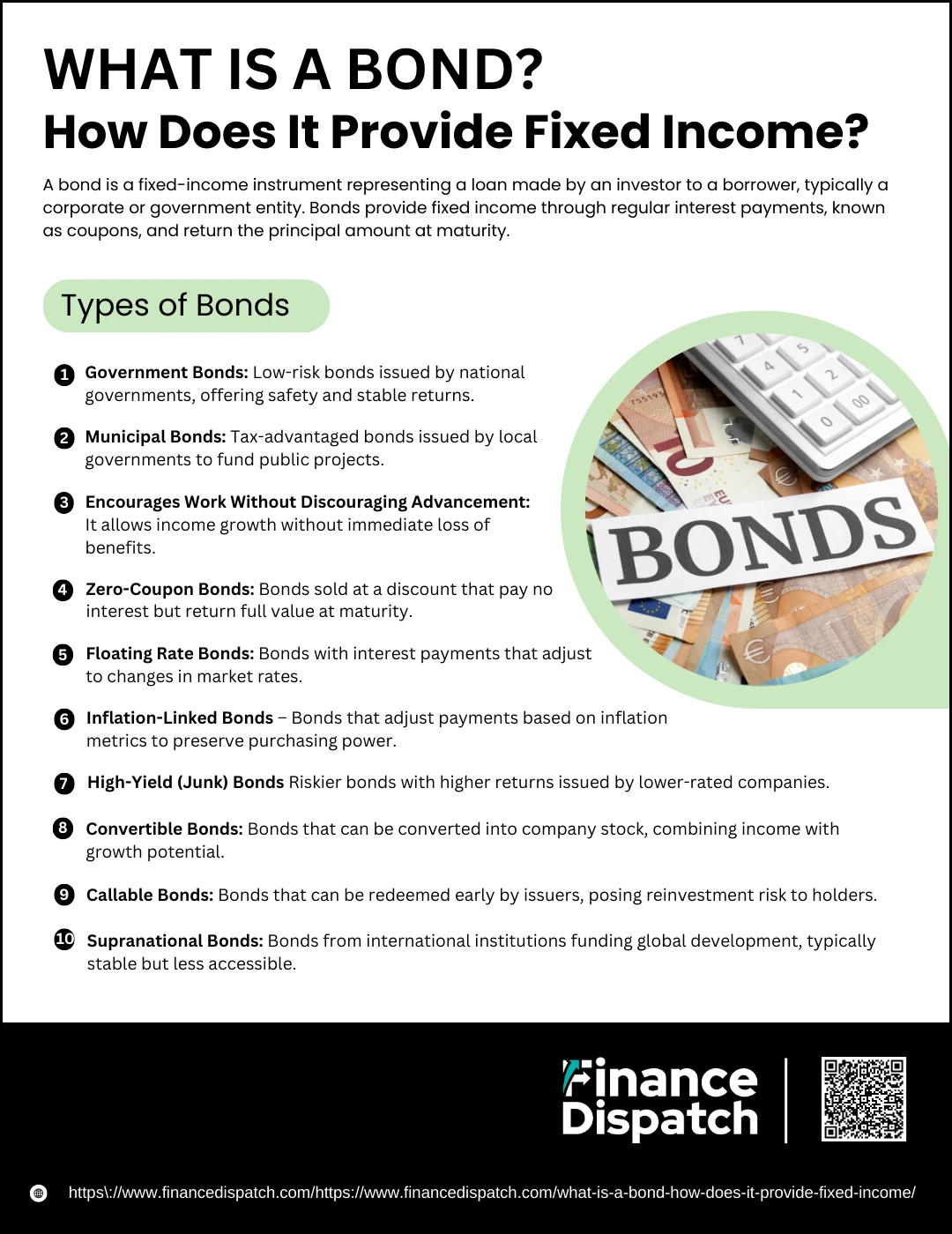 Types of Bonds
Types of Bonds
Bonds are not one-size-fits-all—each type serves a unique purpose, carries different levels of risk, and responds differently to changes in the economy. By understanding the various types of bonds, you can build a more balanced and goal-oriented investment portfolio.
1. Government Bonds
Government bonds are issued by national governments to raise funds for public services and infrastructure. In the U.S., they include Treasury Bills (short-term), Treasury Notes (intermediate-term), and Treasury Bonds (long-term). These are widely considered among the safest investments because they are backed by the full faith and credit of the government. While they offer lower yields, their stability makes them attractive during uncertain economic periods.
2. Municipal Bonds
Municipal bonds—or “munis”—are issued by states, cities, or counties to finance local projects such as schools, highways, and water systems. The key advantage of these bonds is their tax-exempt status: interest earned is often free from federal income taxes and, in some cases, state and local taxes. There are two main types: General Obligation Bonds, backed by taxing power, and Revenue Bonds, backed by the income generated from the funded project.
3. Corporate Bonds
These are bonds issued by companies to finance business operations, acquisitions, or capital investments. Corporate bonds generally offer higher interest rates than government bonds because they come with greater risk—especially if the issuing company faces financial uncertainty. They range from investment-grade (lower risk) to high-yield or “junk” bonds (higher risk, higher potential return).
4. Zero-Coupon Bonds
Unlike traditional bonds, zero-coupon bonds do not pay regular interest. Instead, they are sold at a deep discount to their face value and pay the full amount at maturity. The difference between the purchase price and the face value represents the investor’s return. These are suited for long-term goals like saving for college or retirement, but they are more sensitive to interest rate changes.
5. Floating Rate Bonds
These bonds have interest payments that fluctuate based on a benchmark interest rate, such as the LIBOR or federal funds rate. This feature helps protect investors in rising interest rate environments, making floating rate bonds an attractive choice during periods of economic tightening.
6. Inflation-Linked Bonds
These bonds are structured to protect against inflation. Their principal or interest payments are adjusted periodically based on inflation indicators, like the Consumer Price Index (CPI). For example, Treasury Inflation-Protected Securities (TIPS) in the U.S. increase in value with inflation, helping investors preserve purchasing power.
7. High-Yield (Junk) Bonds
High-yield bonds are issued by companies with lower credit ratings, meaning there’s a greater risk that the issuer might default. To compensate for this higher risk, these bonds offer much higher interest rates. They can deliver attractive returns, but they are more vulnerable to economic downturns and changes in investor sentiment.
8. Convertible Bonds
Convertible bonds are corporate bonds that give investors the option to convert the bond into a predetermined number of shares of the issuing company’s stock. They offer fixed interest payments but provide the opportunity to benefit from a company’s rising share price. This makes them a hybrid between debt and equity, appealing to investors who want income with upside potential.
9. Callable Bonds
Callable bonds can be redeemed (or “called”) by the issuer before the maturity date—usually when interest rates decline, allowing the issuer to refinance at lower costs. While they generally offer higher yields to compensate for this risk, investors may face reinvestment challenges if the bond is called early during a low-interest rate environment.
10. Supranational Bonds
Issued by multinational organizations such as the World Bank or the Asian Development Bank, these bonds fund international development projects. They tend to be high quality and offer strong creditworthiness, but they are less common in retail investment portfolios. They may also carry currency and geopolitical risks if issued in foreign markets.
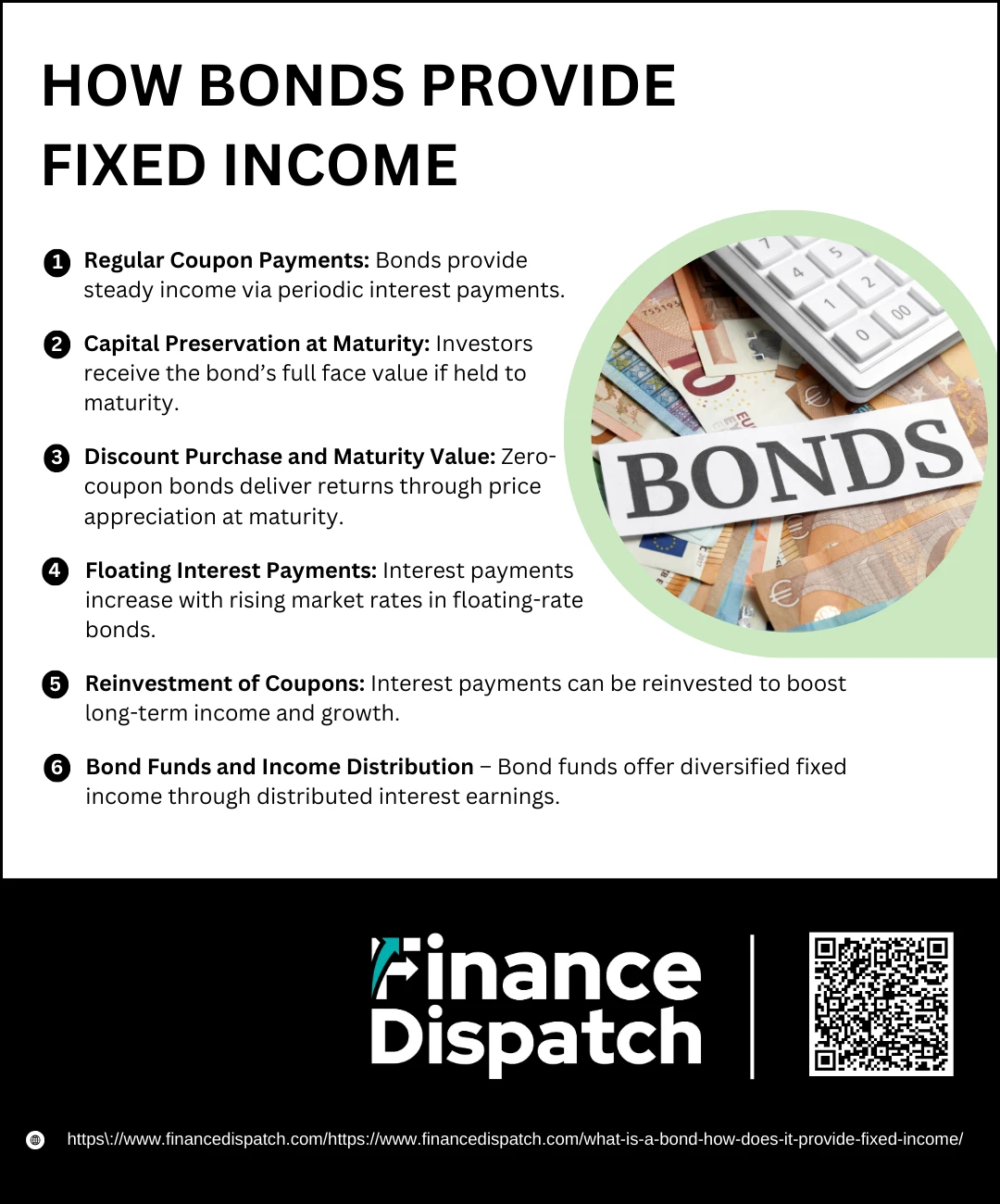 How Bonds Provide Fixed Income
How Bonds Provide Fixed Income
Bonds are popular among investors seeking a predictable and steady income stream. When you invest in a bond, you’re essentially lending money to a government or corporation in exchange for interest payments, which are made regularly until the bond matures. These payments, known as coupons, are what make bonds a key source of fixed income. But that’s not the only way bonds can generate returns.
1. Regular Coupon Payments
Most bonds pay fixed interest—called coupons—either annually or semi-annually. For example, a bond with a 5% coupon rate and a $1,000 face value will pay $50 per year. These payments provide consistent income for investors, which is especially appealing for retirees or anyone seeking stability.
2. Capital Preservation at Maturity
At the end of a bond’s term (maturity), the issuer repays the full face value of the bond. If held to maturity, this guarantees return of capital, which helps preserve your investment while earning regular interest throughout the bond’s life.
3. Discount Purchase and Maturity Value
Some bonds, like zero-coupon bonds, are sold at a deep discount and pay no periodic interest. Instead, they provide income by appreciating in value—paying the full face value at maturity. The difference between the purchase price and maturity value is the investor’s return.
4. Floating Interest Payments
Floating rate bonds adjust their interest payments based on prevailing market rates. This means as interest rates rise, so does the income you earn from the bond—helping maintain purchasing power and adapt to changing economic conditions.
5. Reinvestment of Coupons
Investors can reinvest the interest payments received from bonds into other investments, compounding their returns over time. This reinvestment strategy can help grow wealth and enhance the overall income generated from a bond portfolio.
6. Bond Funds and Income Distribution
When you invest in bond mutual funds or ETFs, you gain exposure to a diversified portfolio of bonds. These funds regularly distribute the income earned from the underlying bonds to shareholders, offering a simple way to access fixed income with added diversification.
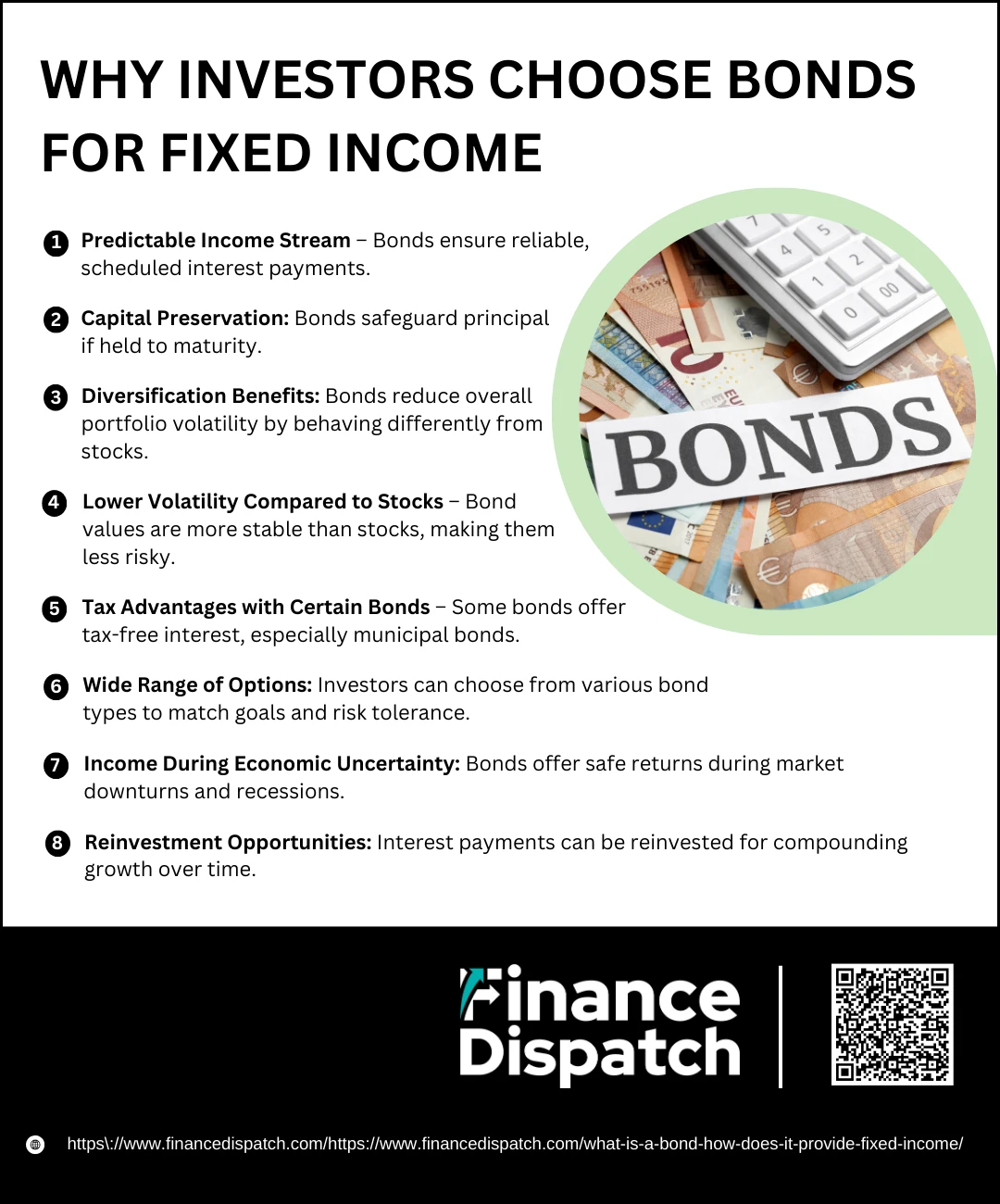 Why Investors Choose Bonds for Fixed Income
Why Investors Choose Bonds for Fixed Income
Bonds are one of the most trusted financial tools for generating reliable income. Whether you’re a retiree seeking steady cash flow or a cautious investor looking to balance out a riskier portfolio, bonds offer a sense of financial stability. Their structured nature, predictable interest payments, and ability to preserve capital make them an appealing option across all stages of investing. Let’s explore the key reasons why investors often turn to bonds as a primary source of fixed income.
Reasons Investors Choose Bonds for Fixed Income
1. Predictable Income Stream
Bonds provide scheduled interest payments, known as coupon payments, typically on a semi-annual basis. These regular cash flows allow investors to plan their finances with greater confidence. For income-focused investors—like retirees—this predictability is a significant advantage over dividend-paying stocks, which can vary or be cut altogether.
2. Capital Preservation
When held to maturity, most bonds return the full face value of the initial investment. This capital protection, combined with regular interest, makes bonds ideal for preserving wealth over time, especially when compared to riskier assets that may lose value.
3. Diversification Benefits
Bonds often behave differently from stocks, especially during market downturns. When equity markets decline, bond values can remain stable or even increase. Adding bonds to a portfolio helps reduce overall volatility and smooth out returns across economic cycles.
4. Lower Volatility Compared to Stocks
Bonds are generally less susceptible to market swings and economic shocks than stocks. Their values don’t change as drastically, offering a more stable investment. This reduced volatility is appealing for conservative investors and those close to retirement who want to avoid large losses.
5. Tax Advantages with Certain Bonds
Municipal bonds, issued by local governments, often offer tax-free interest at the federal level—and sometimes at the state and local levels too. This tax efficiency can significantly enhance net returns, particularly for investors in higher income brackets.
6. Wide Range of Options
The bond market offers various types of bonds to suit different needs. Investors can choose from government bonds (low risk), corporate bonds (higher yield), inflation-linked bonds (protection against inflation), or high-yield bonds (higher risk and return). This flexibility allows investors to tailor their bond investments based on income goals and risk tolerance.
7. Income During Economic Uncertainty
In times of economic instability or recession, investors tend to seek safety in bonds. Government and high-quality corporate bonds are often seen as “safe havens,” providing consistent returns even when other asset classes suffer.
8. Reinvestment Opportunities
The interest income from bonds can be reinvested to purchase additional bonds or other assets. Over time, this reinvestment can lead to compounding returns, enhancing the overall performance of the fixed income portion of a portfolio.
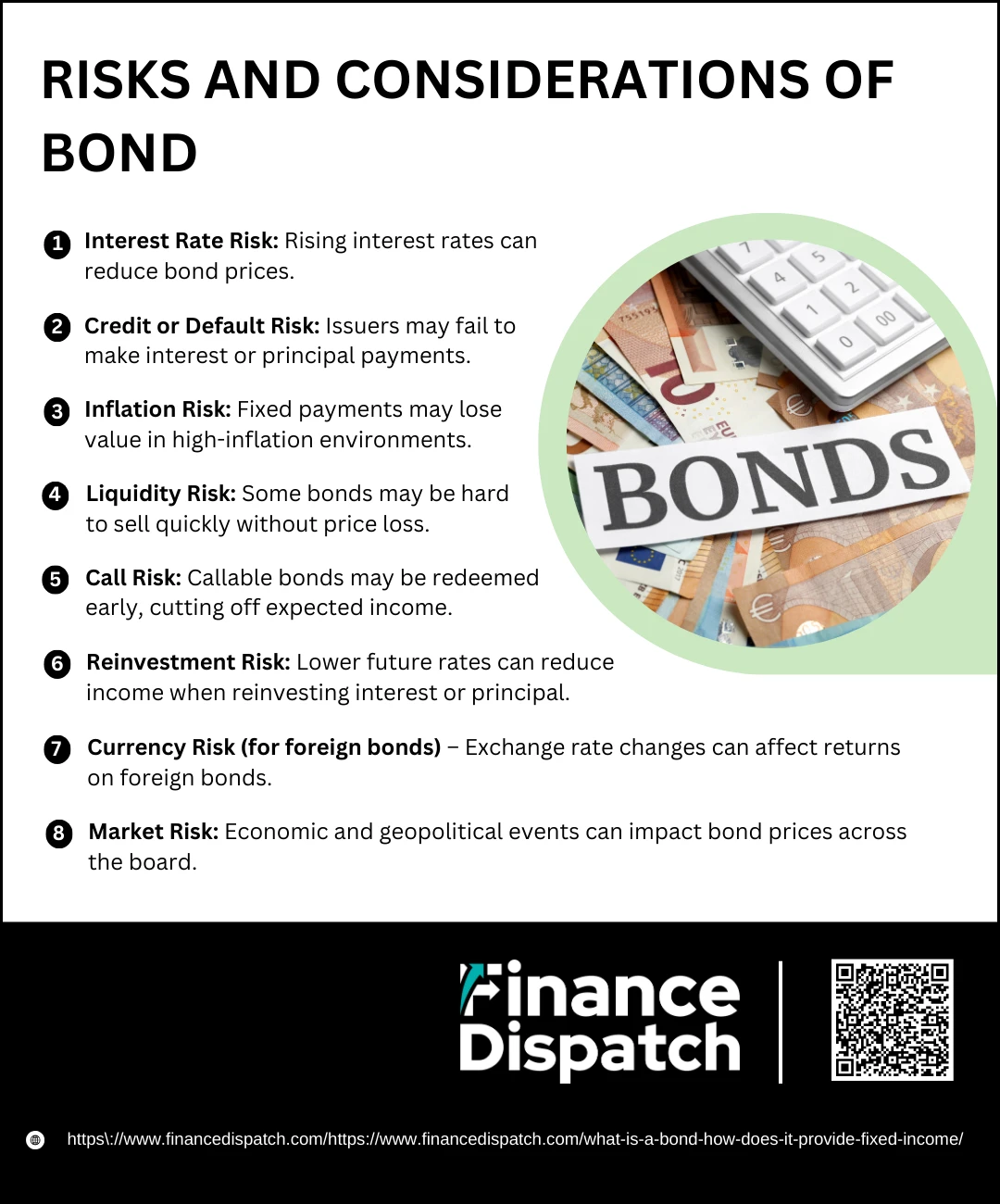 Risks and Considerations of Bond
Risks and Considerations of Bond
While bonds are often seen as safer than stocks, they are not without risk. Understanding the potential downsides is essential before adding bonds to your portfolio. Different types of bonds carry varying levels of risk, and market conditions can significantly affect their performance. Being aware of these risks helps investors make informed decisions and manage their fixed income investments more effectively.
Key Risks and Considerations of Investing in Bonds
1. Interest Rate Risk
Bond prices and interest rates move in opposite directions. When market interest rates rise, the value of existing bonds tends to fall because newer bonds offer better returns. This can lead to capital losses if you need to sell your bond before it matures.
2. Credit or Default Risk
This is the risk that the bond issuer may fail to make timely interest payments or repay the principal. Government bonds typically have lower default risk, while corporate and high-yield (junk) bonds carry higher credit risk depending on the issuer’s financial health.
3. Inflation Risk
Fixed interest payments may lose purchasing power over time if inflation rises. Even if you receive regular payments, they might not keep up with rising costs, reducing your real returns.
4. Liquidity Risk
Some bonds can be difficult to sell quickly at a fair price, especially those issued by smaller companies or in times of market stress. This lack of liquidity can be a challenge if you need to access your money in a hurry.
5. Call Risk
Certain bonds, known as callable bonds, can be redeemed by the issuer before maturity, usually when interest rates fall. This means investors may lose out on future interest payments and be forced to reinvest at lower rates.
6. Reinvestment Risk
If interest rates decline, any interest payments or returned principal may need to be reinvested at lower rates, reducing your future income potential. This is particularly relevant for laddered bond strategies or bond funds.
7. Currency Risk (for foreign bonds)
Bonds issued in foreign currencies can expose investors to exchange rate fluctuations. A decline in the foreign currency’s value can reduce the overall return when converted back into your local currency.
8. Market Risk
Broader market conditions, such as economic downturns, geopolitical events, or shifts in investor sentiment, can impact bond prices—even those with low credit or interest rate risk.
Investing in Bonds vs. Bond Funds
When it comes to fixed income investing, you have two main options: buying individual bonds or investing in bond funds. Both approaches can provide regular income and help diversify your portfolio, but they differ in terms of risk, cost, flexibility, and management. Understanding the pros and cons of each option can help you choose the strategy that best fits your investment goals and risk tolerance.
Comparison Table: Individual Bonds vs. Bond Funds
| Feature | Individual Bonds | Bond Funds (Mutual Funds or ETFs) |
| Investment Control | You choose specific bonds to hold until maturity | Fund manager selects a diversified portfolio |
| Return Predictability | Known interest and face value at maturity if held | Returns vary; influenced by market conditions |
| Diversification | Limited unless large capital is invested | High; spreads risk across many issuers and sectors |
| Liquidity | May be harder to sell, especially in low-demand markets | Highly liquid; can redeem (mutual funds) or trade (ETFs) |
| Minimum Investment | Often high (e.g., $1,000 to $10,000 per bond) | Lower entry points; suitable for smaller investors |
| Management | Self-managed or via advisor | Professionally managed by experienced fund managers |
| Fees/Costs | May include broker commissions and bid/ask spreads | Management fees and possible sales loads (fund-dependent) |
| Income Stability | Fixed payments if held to maturity | Fluctuating income based on underlying bond performance |
| Market Price Fluctuation | Affects bond value if sold before maturity | NAV changes daily with market value of holdings |
Conclusion
Bonds play a crucial role in building a well-rounded investment strategy, especially for those seeking steady income and lower risk. Whether you choose to invest in individual bonds or bond funds, understanding how they work, the types available, and the risks involved helps you make smarter financial decisions. Bonds offer more than just interest payments—they provide stability, capital preservation, and diversification. When used thoughtfully, they can be a reliable source of fixed income and a valuable tool for achieving long-term financial goals.



